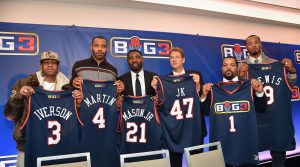In case you didn’t know it, 3-on-3 basketball is the number one urban team sport in the world. FIBA, basketball’s international federation, continues its full-court press to get the half-court game into the Olympics. FIBA has been pushing to bring 3-on-3 from the streets to the world stage, and it’s getting close.
Well this summer, BIG3 will give the sport its biggest stage yet.
BIG3 – the 3-on-3 pro basketball league co-founded by legendary rapper/actor/entrepreneur Ice Cube – tips off on June 24 with a roster of 40 former NBA players, including all-world athletes such as Allen Iverson, Chauncey Billups and Jermaine O’Neal.
The league consists of eight teams, five players to a squad. No doubt all 40 of these guys grew up playing 3-on-3 ball in their neighborhood gyms and playgrounds. But it’s a safe bet they’ve never played 3-on-3 in a competitive atmosphere with and against the best players in the world.
“When I got the call, it was a no-brainer,” said Iverson, the four-time scoring champ who retired from the NBA in 2010. “This is gonna go on and on and on,” he said about the potential staying power of BIG3. “It’s going to be part of our culture.”
So what can fans expect? All the players who have signed on to be part of the inaugural season have emphatically declared the competitive juices will be flowing.
“We can still play and play really well,” said Billups, who retired three seasons ago and is still 10th on the NBA’s all-time three-point list.
Many of the BIG3 players will tell you they’re excited about the half-court format. Another big element – and this is different from international 3-on-3 rules – is that there is a three-point line. Oh, and there are three circles further out beyond the three-point line. Sink a shot from one of those marks and it’s a four-pointer.
Make no mistake, though. While the half-court setting may limit the running, there will be plenty of action.

“Players get more opportunities to affect the game in 3×3,” said Eric Flannery, a veteran USA Basketball coach who took a USA Basketball team to the FIBA 3×3 World Championships in 2010. “To me, it simply provides more opportunities for players to make basketball decisions that impact the game.”
Mike Jones, head coach at legendary basketball power DeMatha Catholic High School in Maryland, loves to use 3-on-3 in practice because it makes his players work harder.
“You cannot hide on offense or defense in 3-on-3,” said Jones, who has coached a number of NBA players at DeMatha including current Oklahoma City guard Victor Oladipo. “With 10 players on the floor, you can go multiple possessions without being involved. That’s not feasible in 3-on-3.”
With every player involved, that means fans at a BIG3 event get to see literally dozens of legends in action. That’s because the league setup calls for all eight teams to play in a single day – every Saturday from June 24 through the championships on Aug. 26, each week at a different venue. The first eight weeks will determine team rankings. The teams are divided into two brackets for playoff games in Week 9, with a best-of-three finals in Week 10 between the top two seeds.
When the dust settles, there will be a clear-cut 1-8 ranking – and players get paid a percentage of the revenue based on their team ranking. Another reason these guys won’t just be going through the motions.
“Because what we didn’t want to do was put on an all-star game and not have a game,” Ice Cube told The Undefeated. “You know, we want All-Stars there playing hard.”
Another new wrinkle for the BIG3 is the game format. No clock. Instead, the winner of each game is the first team to reach 60 points (with a short halftime when a team gets to 30).
“We felt like a game to 60 is exciting. You have a finish line over a clock that’s running,” said Cube. “Because you’re definitely gonna see enough basketball … We just felt like we know exactly how much basketball we’ll get every time.”



